Retail Chatbots Made Easy: A Practical Guide
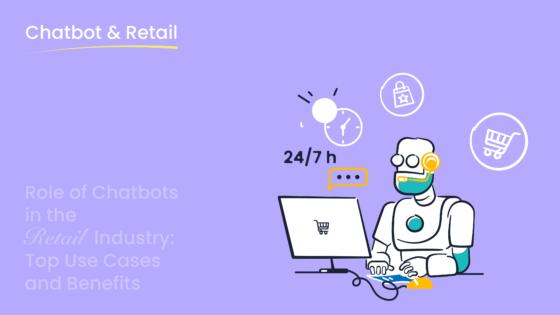
Retail chatbots are revolutionizing how businesses interact with customers. These intelligent tools automate routine tasks, such as answering common questions, which improves efficiency and enhances customer service. For example, studies show chatbots resolve inquiries 82% faster than traditional methods while reducing operational costs by 47%. Over 40% of U.S. consumers have already interacted with chatbots in retail, and 87.2% of users report positive experiences.
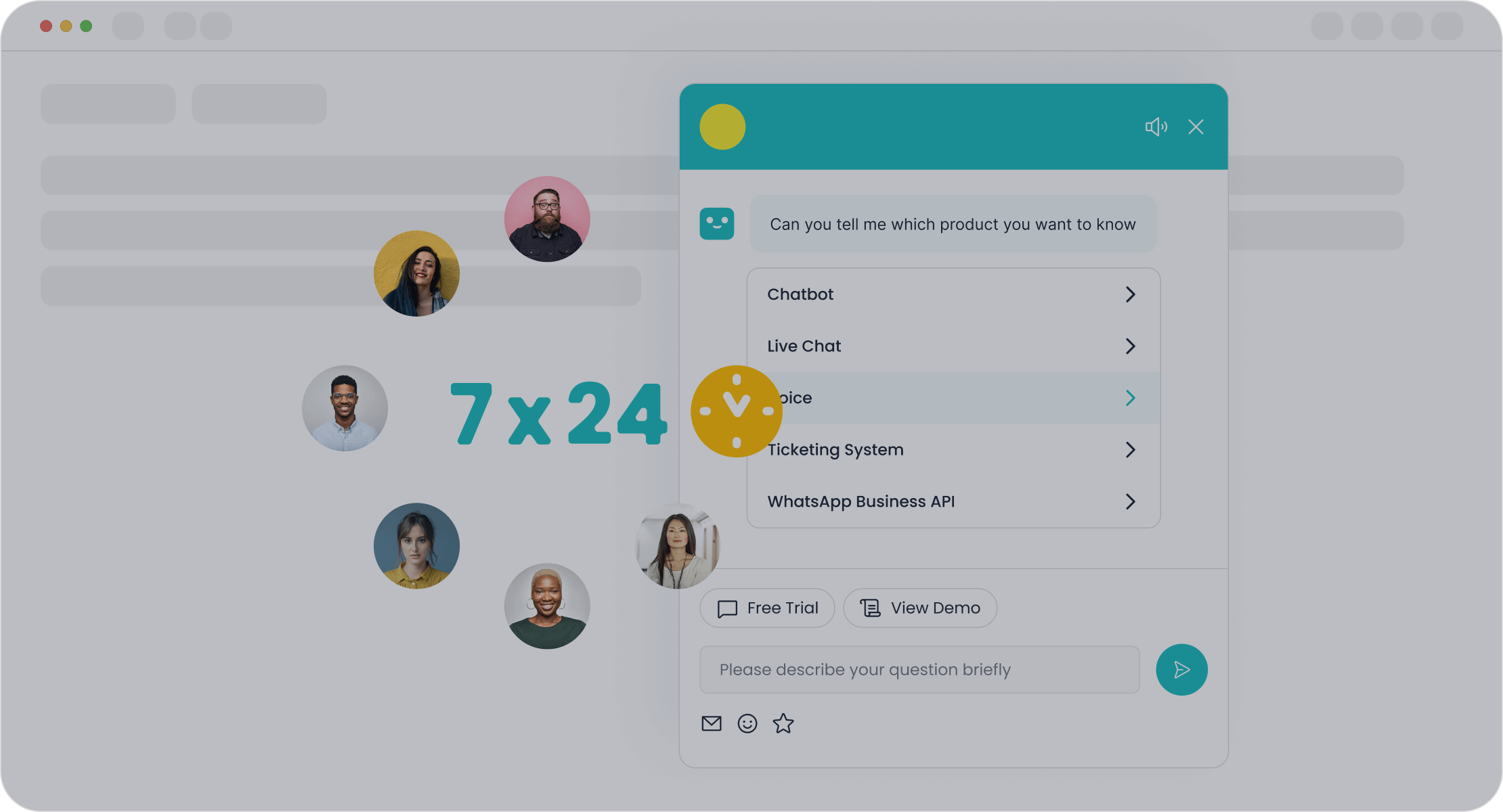
Sobot’s AI-powered chatbot exemplifies this transformation. It offers 24/7 multilingual support, automates repetitive tasks, and integrates seamlessly across platforms. By adopting retail chatbots like Sobot’s, you can streamline operations, cut costs, and deliver exceptional customer service.
Understanding Retail Chatbots
What Are Retail Chatbots?
Retail chatbots are intelligent tools designed to assist customers in the retail sector. They use conversational AI to interact with users through text or voice, providing instant responses to inquiries. These chatbots automate tasks like answering questions, recommending products, and managing orders. By leveraging advanced technologies like machine learning and natural language processing (NLP), they deliver personalized experiences based on customer behavior.
For example, imagine a customer asking about the availability of a specific product. A retail chatbot can instantly check inventory and provide accurate details, saving time and enhancing satisfaction. With adoption rates soaring, retail chatbots are becoming essential for businesses aiming to improve efficiency and customer engagement.
| Statistic | Value |
|---|---|
| Online shoppers likely to complete a purchase with chatbot assistance | 83% |
| Expected global chatbot market in eCommerce by 2027 | $9.4 billion |
| Expected CAGR for global chatbot market | 24.3% |
How Do Retail Chatbots Work?
Retail chatbots operate through a series of intelligent processes:
- Understanding Customer Inquiries: Chatbots analyze customer messages using NLP to identify intent and context. For instance, if a customer asks, "Do you have this jacket in size medium?", the chatbot recognizes the product and size requested.
- Providing Personalized Assistance: After understanding the query, the chatbot accesses inventory systems to check availability. It then responds with real-time information, offering alternatives if the item is out of stock.
- Handling Transactions and Orders: Chatbots facilitate purchases by verifying inventory, processing payments, and sharing shipping details. This automation streamlines the buying process.
- Escalation to Human Support: For complex issues, chatbots transfer the conversation to human agents, ensuring a seamless transition. They compile relevant details to help agents resolve the problem efficiently.
These mechanisms make retail chatbots indispensable for businesses. They reduce customer abandonment rates, save time, and improve overall service quality.
Common Features of Retail Chatbots
Retail chatbots come equipped with features that enhance their functionality and usability:
- Omnichannel Support: Chatbots interact across platforms like WhatsApp, SMS, and social media, ensuring customers can reach you wherever they prefer.
- Personalization: Machine learning enables chatbots to analyze customer interactions and provide tailored recommendations.
- Automation: Chatbots handle up to 69.2% of consumer conversations, reducing the need for human intervention.
- Integration: They connect with systems like CRM and ERP to deliver real-time information and streamline operations.
- 24/7 Availability: Chatbots operate round-the-clock, ensuring customers receive assistance anytime.
| Feature | Statistic |
|---|---|
| Automation Potential | 69.2% of consumer conversations |
| Opportunity for Expense Savings | Significant through automation |
Sobot’s AI-powered chatbot exemplifies these features. It offers multilingual support, integrates seamlessly with existing systems, and operates 24/7. By adopting conversational AI chatbots like Sobot’s, you can enhance customer satisfaction while reducing costs.
Benefits of Retail Chatbots for Businesses
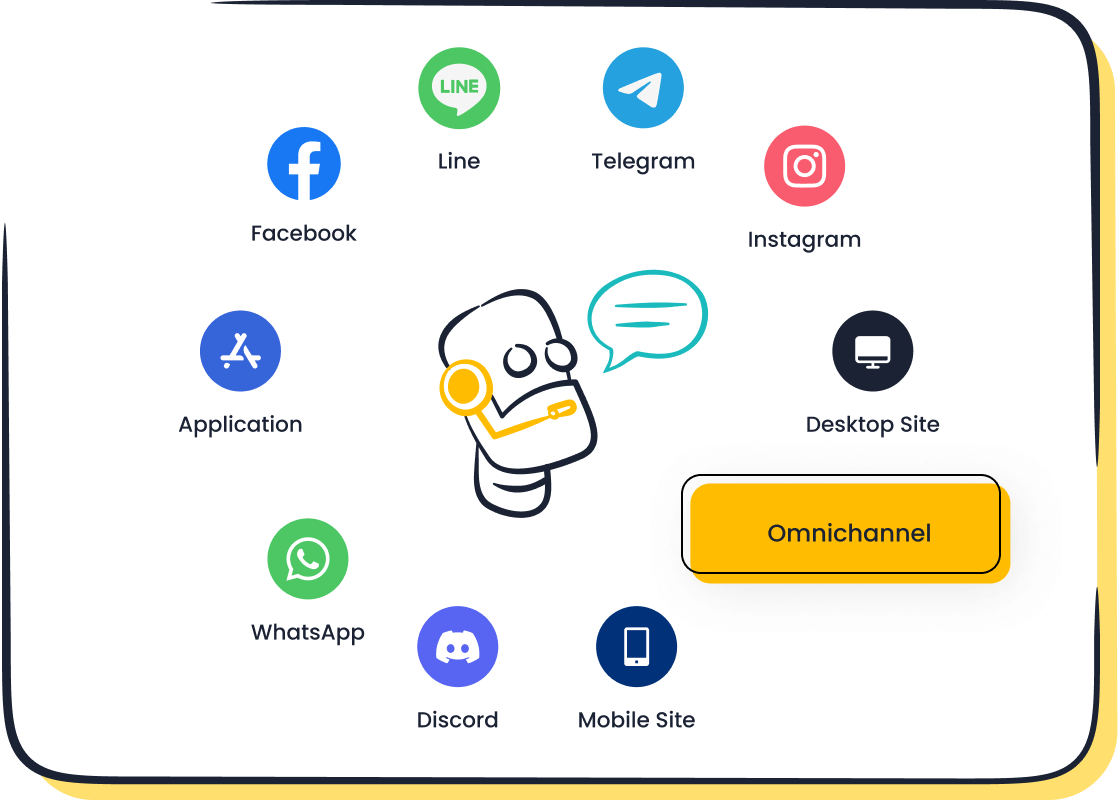
Enhancing Customer Service with Retail Chatbots
Retail chatbots transform customer service by providing instant, accurate responses to inquiries. They handle routine tasks like answering FAQs, tracking orders, and resolving common issues, freeing human agents to focus on complex problems. This automation improves efficiency and ensures better customer service. For example, chatbots reduce the average response time by 82%, enhancing customer satisfaction.
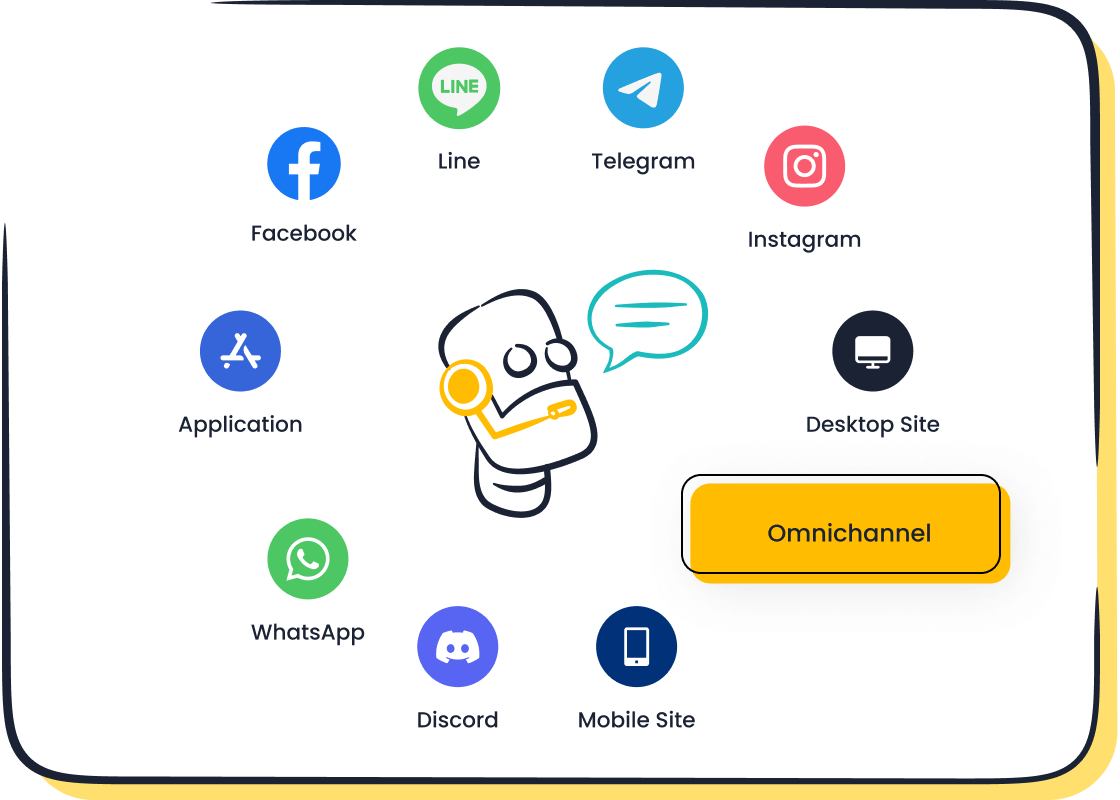
Retailers like Sephora use chatbots to book appointments and offer makeup tutorials, improving customer engagement and staff productivity. Additionally, chatbots collect feedback after purchases, allowing businesses to address concerns quickly and build customer trust. With Sobot’s AI chatbots, you can deliver round-the-clock assistance across multiple channels, ensuring seamless customer interactions.
Tip: Chatbots cost just $0.50 per interaction compared to $6.00 for human agents, making them a cost-effective solution for scaling customer support.
Driving Sales Through a Personalized Shopping Experience
Retail chatbots excel at creating personalized shopping experiences. They analyze customer preferences, past purchases, and browsing behavior to offer tailored product recommendations. This personalization boosts customer engagement and drives higher sales and conversions.
For instance, chatbots recover abandoned carts by sending reminders and incentives, reducing cart abandonment rates by 20–30%. They also create interactive experiences, such as virtual try-ons, which enhance customer satisfaction. Sobot’s AI-powered chatbots act as personalized shopping assistants, helping customers find products that match their needs while improving conversions by 20%.
| Use Case | Description |
|---|---|
| Personalized Recommendations | Chatbots provide tailored product suggestions based on user preferences and past purchases. |
| Cart Abandonment Recovery | Chatbots send reminders and incentives to users who abandon their carts, encouraging them to complete purchases. |
| Interactive Experiences | Chatbots create engaging experiences, such as virtual try-ons, enhancing customer interaction. |
Streamlining Operations and Reducing Costs
Retail chatbots streamline operations by automating repetitive tasks and reducing the workload on human agents. They handle high volumes of customer interactions efficiently, allowing businesses to focus on strategic initiatives. Chatbots also operate 24/7, eliminating the need for additional staffing during off-hours.
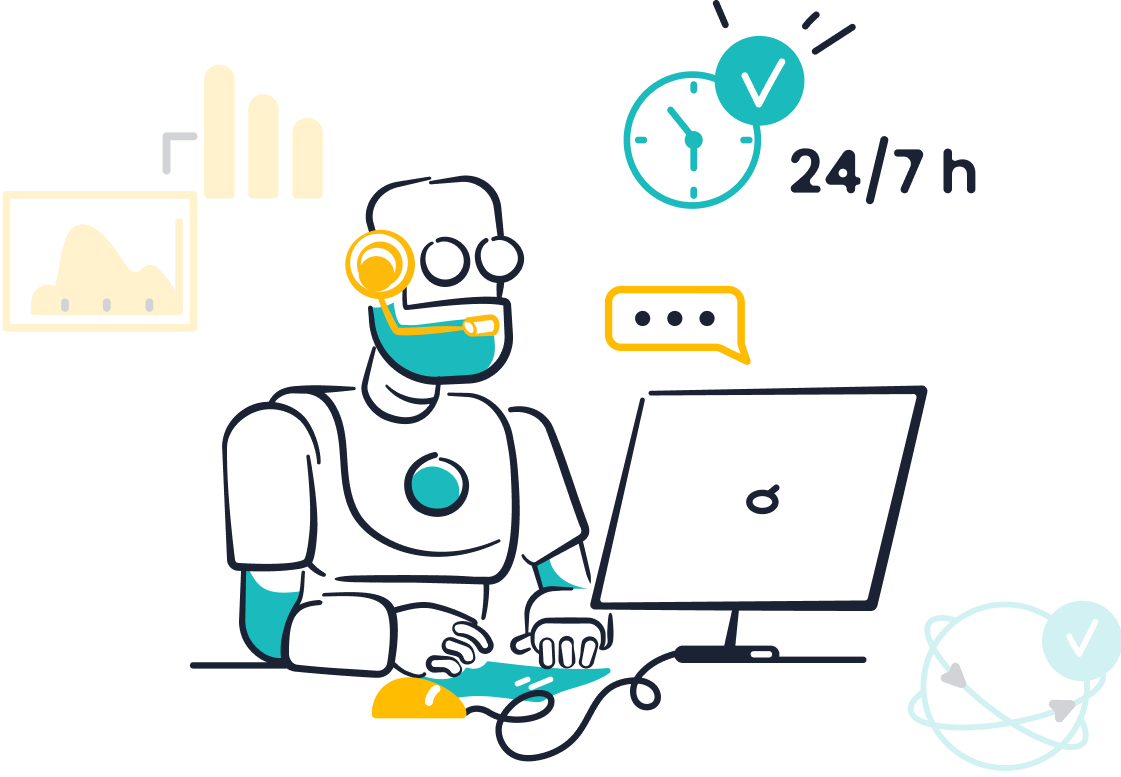
Sobot’s AI chatbots integrate seamlessly with CRM and ERP systems, ensuring smooth operations and real-time data access. This integration reduces staffing requirements and training costs, saving businesses up to 30% on customer service expenses. By automating responses to common inquiries, chatbots improve operational efficiency and enhance customer self-service options.
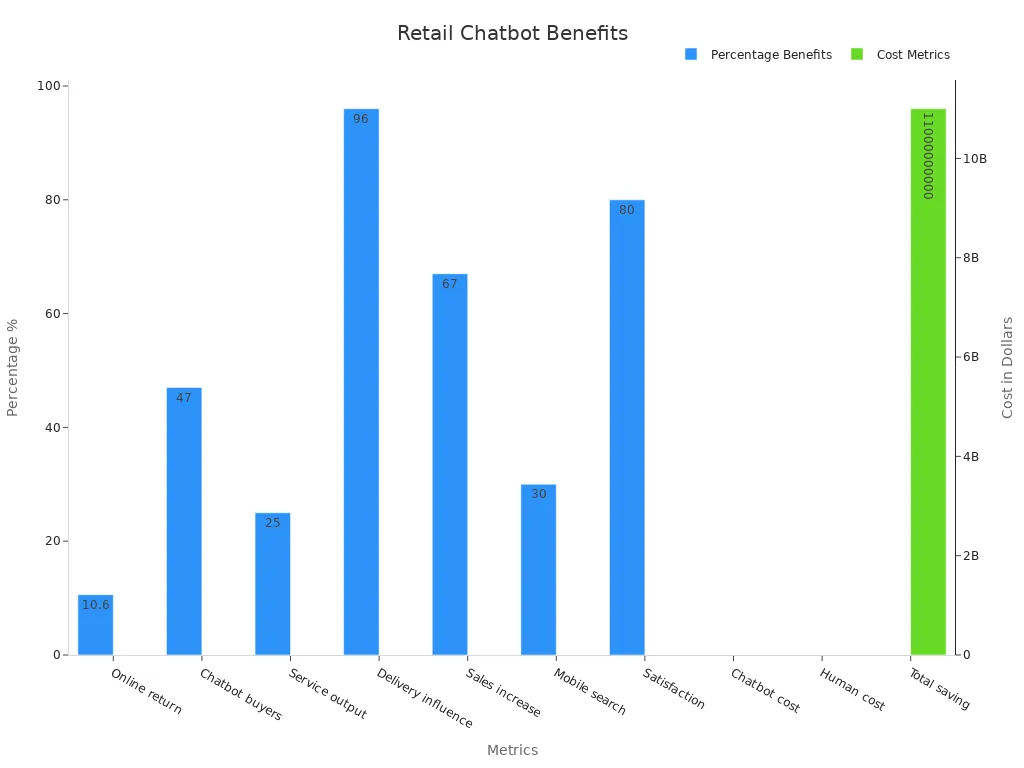
Note: In 2022, chatbots saved businesses $11 billion globally, highlighting their impact on cost reduction and operational efficiency.
Real-World Applications of Retail Chatbots
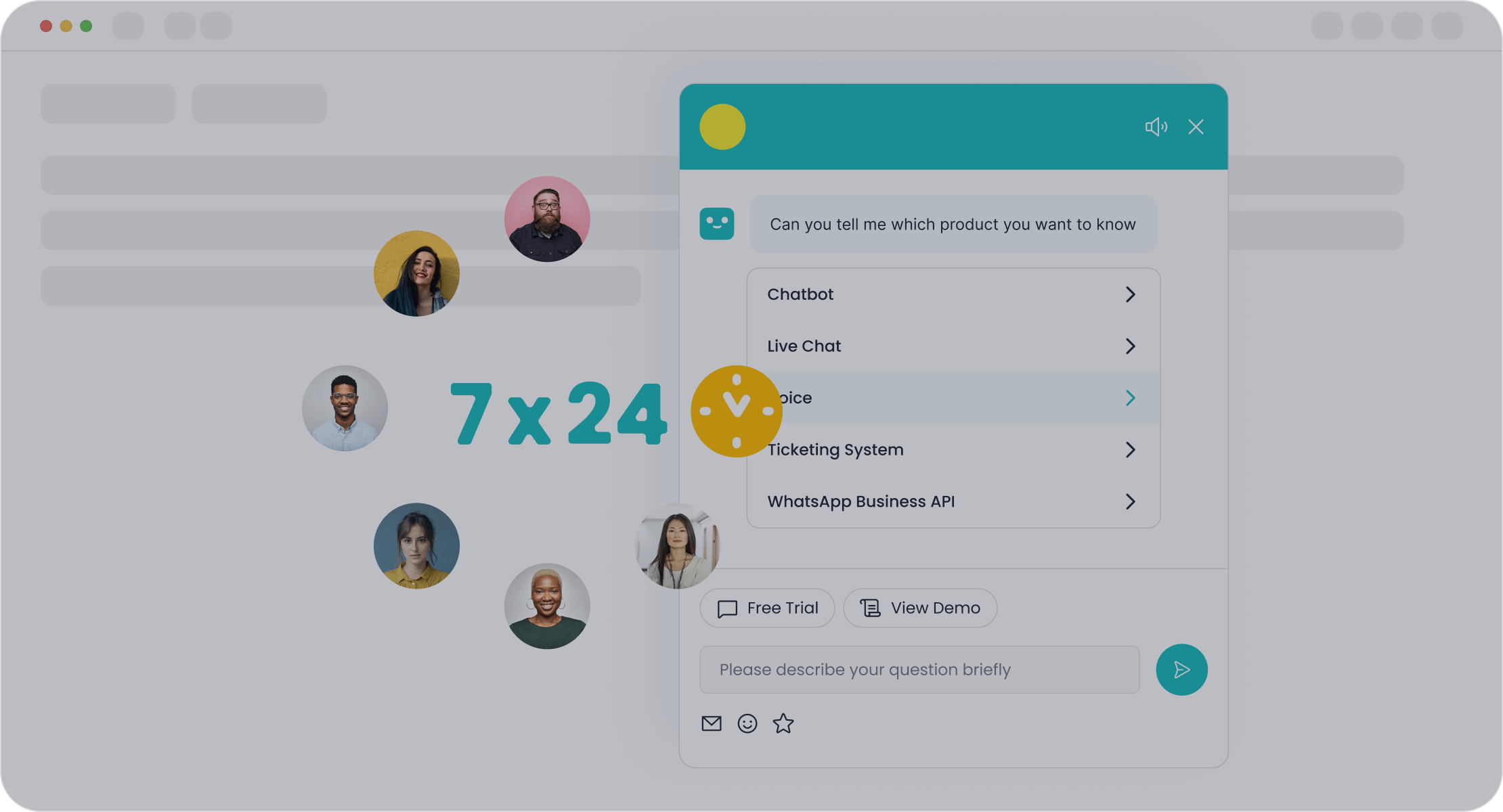
Virtual Shopping Assistants for Personalized Shopping
Retail chatbots act as virtual shopping assistants, offering tailored recommendations based on your preferences and browsing history. These AI chatbots analyze past purchases and real-time interactions to suggest products that match your needs. For example, Amazon generates 35% of its revenue through personalized recommendations, showcasing the power of tailored suggestions.
Virtual shopping assistants also create engaging experiences, such as virtual try-ons or style matching. This personalization boosts customer loyalty and increases conversion rates. Studies show that 47% of Gen Z and 46% of Millennials prefer personalized product recommendations, while 40% value customized service in e-commerce. With Sobot’s AI chatbots, you can deliver these experiences seamlessly across platforms, enhancing customer satisfaction and driving sales.
| Evidence Description | Source |
|---|---|
| Virtual Shopping Assistants enhance customer engagement and provide personalized recommendations, leading to increased conversion rates and customer loyalty. | Kindly.ai |
| 54% of French consumers see relevant product recommendations as a 'plus', while 33% deem them 'essential'. | Kindly.ai |
Order Tracking and Updates
Order tracking is one of the most practical applications of retail chatbots. These tools provide real-time updates on order status, delivery schedules, and shipping details. You can access this information anytime, thanks to their 24/7 availability. Instant responses reduce frustration and build trust by keeping you informed about your purchases.
Chatbots also proactively address issues, such as delays or incorrect shipments, before they escalate. This commitment to customer satisfaction strengthens relationships and reduces complaints. For example, Sobot’s AI chatbots integrate with inventory and logistics systems, ensuring accurate and timely updates. Enhanced communication through order tracking improves user experience and fosters loyalty.
Note: Improved order tracking systems provided by chatbots lead to stronger customer relationships and reduced misunderstandings.
Fraud Detection and Prevention
Retail chatbots play a crucial role in fraud detection and prevention. By analyzing patterns in customer behavior and transaction data, they identify suspicious activities and flag potential risks. For instance, if a chatbot detects unusual purchase patterns or multiple failed login attempts, it can alert you or escalate the issue to human agents.
AI chatbots also verify customer identities during transactions, adding an extra layer of security. This reduces fraud-related losses and protects sensitive information. Sobot’s AI-powered chatbots leverage advanced algorithms to monitor transactions and ensure compliance with data protection regulations. By integrating these tools, you can safeguard your business and enhance customer trust.
| Application Area | Description | Benefits |
|---|---|---|
| Fraud Detection and Prevention | Identifies suspicious activities and flags risks. | Reduces fraud-related losses and protects sensitive information. |
| Customer Support | Handles inquiries about product details, shipping policies, etc. | Immediate and accurate information, enhances customer experience, reduces workload for staff. |
Product Recommendations and Upselling
Retail chatbots excel at recommending products and driving upselling opportunities. These AI-powered tools analyze customer behavior, past purchases, and browsing patterns to suggest items tailored to individual preferences. By offering personalized recommendations, chatbots create engaging shopping experiences that boost customer satisfaction and increase sales.
For example, imagine a customer browsing for a smartphone. A chatbot can suggest compatible accessories like cases or headphones, encouraging additional purchases. This strategy not only enhances the shopping experience but also increases your revenue. Studies show that chatbot-powered recommendations can raise eCommerce revenue by 7–25%.
Tip: Personalized recommendations reduce cart abandonment rates and improve customer loyalty.
Chatbots also play a vital role in upselling. They identify opportunities to offer premium versions of products or complementary items during the buying process. Automated assistants guide customers toward suitable choices while introducing higher-value options. This approach helps consumers make informed decisions and drives additional sales. By 2025, chatbot transactions in eCommerce are expected to reach $112 billion, highlighting their growing impact on retail.
Sobot’s AI chatbot takes product recommendations and upselling to the next level. It uses advanced algorithms to analyze customer interactions and provide tailored suggestions. Its omnichannel support ensures seamless communication across platforms, while its multilingual capabilities cater to diverse audiences. With Sobot, you can enhance customer engagement, resolve cart abandonment issues, and optimize upselling strategies effortlessly.
Note: Chatbots like Sobot’s improve upselling by offering personalized suggestions based on real-time data, increasing conversions by up to 20%.
| Feature | Benefit |
|---|---|
| Personalized Recommendations | Enhance customer satisfaction and engagement. |
| Upselling Opportunities | Drive additional sales and increase revenue. |
Retail chatbots are transforming how businesses approach product recommendations and upselling. By leveraging tools like Sobot’s AI chatbot, you can deliver tailored shopping experiences that delight customers and maximize profits.
Building and Implementing a Retail Chatbot with Sobot
Choosing the Right Chatbot Platform
Selecting the right platform is the first step in building a retail chatbot. A good platform should integrate seamlessly with your existing systems, offer customization options, and provide advanced natural language processing (NLP) capabilities. It should also include analytics features to help you monitor performance and optimize interactions.
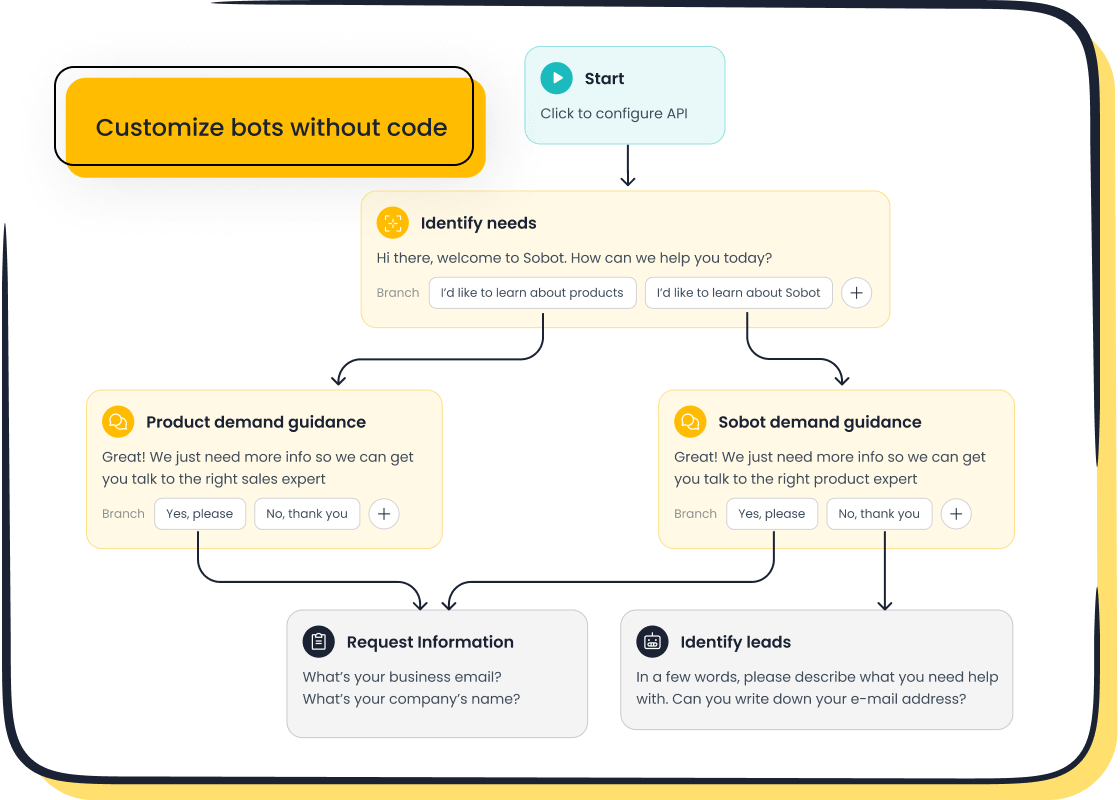
Sobot’s AI-powered chatbot platform checks all these boxes. It supports omnichannel integration, allowing you to connect with customers across platforms like WhatsApp, SMS, and social media. Its no-code interface makes it easy to customize workflows without technical expertise. Additionally, Sobot’s multilingual capabilities ensure you can serve a diverse customer base.
When comparing platforms, consider factors like scalability and ease of use. For example:
- Does the platform integrate with your CRM or ERP systems?
- Can it handle high volumes of customer interactions efficiently?
- Does it offer analytics to track key metrics like resolution rates and customer satisfaction?
A study revealed that 80% of companies intended to adopt chatbots by 2020, highlighting their growing importance. By choosing a robust platform like Sobot, you can ensure a smooth chatbot implementation process and deliver exceptional customer experiences.
| Evidence Type | Statistic/Insight |
|---|---|
| User Satisfaction | 80% of users of Sobot expressed satisfaction |
| Cost Reduction | Significant reduction in customer service costs |
| Economic Impact | Chatbot-based retail sales projected to reach $112 billion by 2023 |
Designing a User-Friendly Chatbot Flow
A well-designed chatbot flow ensures smooth and engaging interactions with your customers. Start by understanding your audience’s goals and motivations. Create user personas to guide your design decisions. For instance, if your customers frequently ask about order tracking, prioritize this feature in your chatbot flow.
Prototyping and testing are essential. Begin with low-fidelity prototypes to map out basic interactions. Gradually refine these into high-fidelity prototypes, testing them with real users to identify usability issues. Personalization is another key factor. Tailor responses based on user data and context to make the interaction feel more human.
Sobot’s chatbot platform simplifies this process with its intuitive drag-and-drop interface. You can design workflows that address common customer queries, such as product recommendations or order updates, without any coding. Its advanced AI capabilities ensure accurate and context-aware responses.
Tip: Monitor key engagement metrics like task completion rates and conversation length to evaluate your chatbot’s effectiveness. Regularly update the flow based on user feedback to keep it relevant and efficient.
Training the Chatbot with Relevant Data
Training your chatbot with high-quality data is crucial for its success. A well-trained chatbot can handle customer queries effectively, reducing the workload on your support team. Start by compiling a robust dataset that includes FAQs, product details, and common customer interactions.
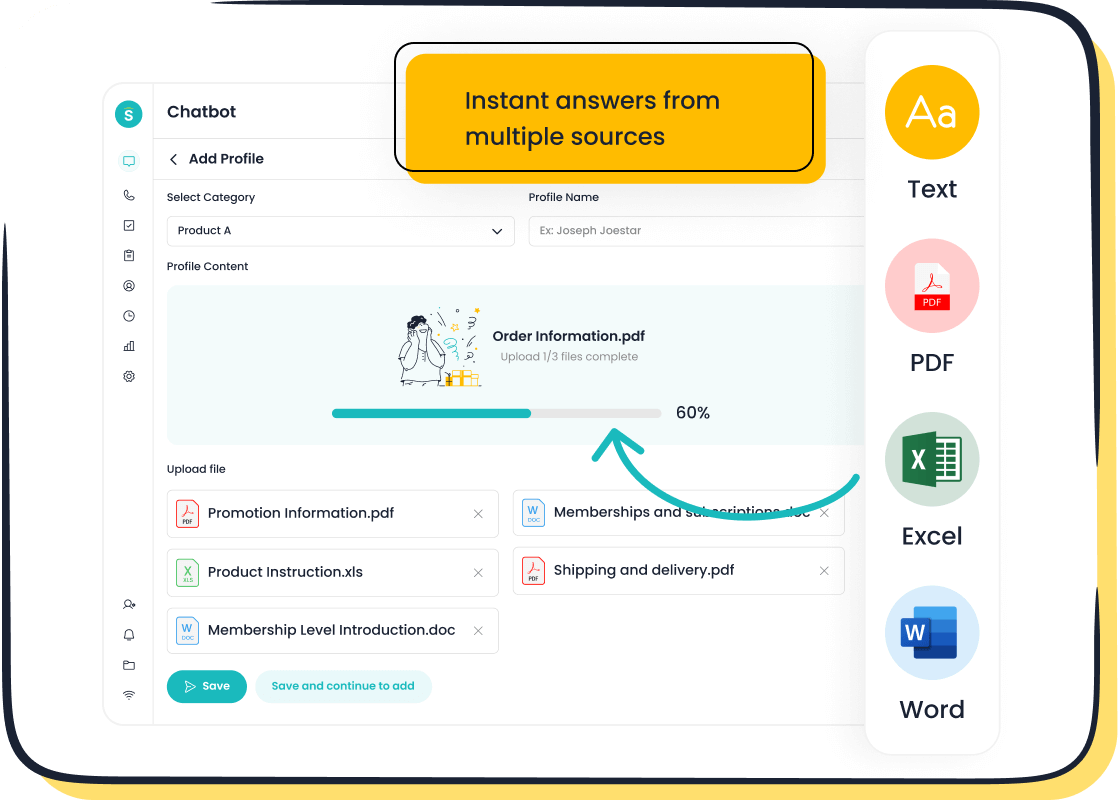
Sobot’s AI chatbots leverage a knowledge base built from various sources, such as articles, PDFs, and text snippets. This ensures your chatbot provides accurate and timely responses. For example, if a customer asks about a product’s availability, the chatbot can instantly check inventory and provide an answer.
Training also involves continuous improvement. Analyze user interactions to identify gaps in your chatbot’s knowledge. Update its training data regularly to enhance its performance. Studies show that well-trained chatbots improve customer sentiment and reduce operational costs.
Note: The quality of your training data directly impacts your chatbot’s ability to deliver a seamless customer experience. Invest time in curating and updating your dataset to maximize its effectiveness.
Integrating the Chatbot with Existing Systems
Integrating a chatbot with your existing systems ensures seamless operations and enhances customer interactions. Begin by identifying the systems your chatbot needs to connect with, such as CRM, ERP, or inventory management platforms. This integration allows the chatbot to access real-time data, enabling it to provide accurate responses and personalized recommendations.
For example, a grocery chain successfully integrated its chatbot with inventory systems to offer instant product availability updates. Similarly, H&M’s chatbot boosted conversion rates by 25% by connecting with its e-commerce platform to deliver tailored fashion suggestions. These integrations streamline workflows and improve customer satisfaction.
To achieve successful integration, follow these steps:
- Assess Compatibility: Ensure your chatbot platform supports integration with your existing tools. Sobot’s chatbot offers omnichannel support, connecting with platforms like WhatsApp and social media effortlessly.

- Use APIs: Application Programming Interfaces (APIs) facilitate smooth data exchange between systems. Sobot’s chatbot leverages APIs to integrate with CRM and ERP systems, ensuring real-time updates.
- Test Data Flow: Verify that data flows correctly between the chatbot and your systems. This step prevents errors and ensures accurate responses.
Tip: Integration improves efficiency and reduces manual tasks, allowing your team to focus on strategic goals.
Several brands have demonstrated the benefits of integration:
- H&M: Chatbot assistance increased conversion rates by 25%.
- Domino’s Pizza: The ‘Dom’ chatbot reduced order completion time by 15%.
- Sephora: Virtual Artist chatbot enhanced engagement and boosted sales.
By integrating your chatbot with existing systems, you create a unified customer experience that drives satisfaction and loyalty.
Testing and Launching Your Retail Chatbot
Testing ensures your chatbot performs as expected before launch. Start by evaluating its functionality in real-world scenarios. Test its ability to handle common queries, provide accurate responses, and escalate complex issues to human agents.
Follow these best practices for testing:
- Simulate User Interactions: Use test cases that mimic customer queries. For example, ask the chatbot about product availability or order tracking.
- Check Mobile Usability: Ensure the chatbot works seamlessly on mobile devices. A retail brand doubled engagement rates by optimizing its chatbot for mobile users.
- Monitor Proactive Messaging: Test how the chatbot initiates conversations. Well-timed prompts improve engagement by 30%.
Once testing is complete, prepare for the launch. Focus on creating a solid content foundation, including FAQs and product details. Sobot’s chatbot simplifies this process by building a knowledge base from articles, PDFs, and text snippets.
During the launch, promote your chatbot across multiple channels. Highlight its features, such as 24/7 availability and multilingual support. Continuous optimization is key. Analyze user interactions to identify areas for improvement and update the chatbot regularly.
| Best Practice | Evidence of Effectiveness |
|---|---|
| Mobile-first layout | Improved usability and reduced friction, leading to doubled engagement rates for a retail brand. |
| Proactive messaging | Clients improved engagement by 30% through well-timed prompts. |
| Continuous testing and optimization | Ongoing testing helps identify weak spots and improve chatbot performance based on user behavior. |
| Solid content foundation | High-quality, accurate content is essential for sustainable chatbot performance. |
Note: Testing and optimization ensure your chatbot delivers consistent, high-quality service, enhancing customer satisfaction and driving sales.
By following these steps, you can launch a chatbot that meets customer expectations and supports your business goals effectively.
Measuring the Success of Your Retail Chatbot
Key Metrics to Evaluate Chatbot Performance
To measure the success of your retail chatbot, focus on key performance metrics that reflect its impact on customer service and business outcomes. These metrics fall into three main categories:
- Customer Care Metrics: Track the chatbot's ability to reduce first-level call rates, email volumes, and escalation rates. For instance, a lower escalation rate indicates the chatbot resolves more queries independently.
- Marketing Metrics: Evaluate conversion rates, session durations, and basket abandonment rates. A chatbot that recovers abandoned carts or increases session engagement directly boosts sales.
- User Experience Metrics: Monitor self-service rates, satisfaction scores, and goal completion rates. High satisfaction scores (CSAT) and Net Promoter Scores (NPS) highlight a positive customer experience.
| Metric Type | Metrics |
|---|---|
| Customer Care Metrics | Decrease of first-level call rate, Duration of calls generated by the chatbot, Escalation rate |
| Marketing Metrics | Conversion rate, Average duration of sessions, Basket abandonment rate |
| User Experience Metrics | Self-service Rate, Satisfaction Rate, Goal Completion Rate |
By analyzing these metrics, you can identify areas where your chatbot excels and where it needs improvement. Sobot’s AI-powered chatbot provides detailed analytics to help you track these metrics effectively, ensuring your chatbot delivers measurable value.
Tools for Monitoring and Optimization
Monitoring tools play a vital role in optimizing your chatbot’s performance. They provide insights into user interactions, helping you refine the chatbot’s functionality. Consider these tools:
- Google Analytics: Tracks website traffic and chatbot engagement metrics, such as bounce rates and session durations.
- Chatbase: Offers detailed analytics for chatbot performance, including conversation flow and user retention.
- MonkeyLearn: Analyzes text data to extract insights and improve the chatbot’s natural language processing capabilities.
Sobot’s chatbot platform integrates seamlessly with these tools, offering built-in analytics to monitor performance. For example, you can track interaction rates and goal completion rates directly within the platform. This integration simplifies the optimization process, allowing you to focus on enhancing customer service.
Tip: Regularly review analytics to identify trends and adjust your chatbot’s responses to meet evolving customer needs.
Iterating Based on Customer Feedback
Customer feedback is a goldmine for improving your chatbot. It reveals gaps in the chatbot’s knowledge and highlights areas for enhancement. Follow these steps to iterate effectively:
- Review chatbot conversations to identify recurring issues or unanswered queries.
- Analyze performance data to uncover trends, such as high fallback rates or low satisfaction scores.
- Implement updates based on findings, refining the chatbot’s responses and capabilities.
| Key Point | Description |
|---|---|
| Continuous Monitoring | Tracks metrics like user engagement and query resolution rates to identify improvement areas. |
| User Feedback | Provides insights that raw data cannot, aligning the chatbot with user needs. |
| Iterative Improvement Process | Involves cycles of monitoring and enhancement, adapting the chatbot to changing user needs. |
| Benefits of Continuous Improvement | Enhances user satisfaction as the chatbot becomes more accurate and responsive. |
Sobot’s chatbot supports iterative improvements by offering tools to analyze user feedback and performance data. For example, you can update its knowledge base with new FAQs or refine its conversational flow to address common pain points. These updates ensure your chatbot remains effective and aligned with customer expectations.
Note: Iterative updates based on automated customer feedback lead to a better customer experience and higher satisfaction rates.
Retail chatbots have transformed customer service and business operations. They automate routine tasks, provide instant responses, and enhance customer engagement. Companies like H&M and Amazon have leveraged chatbots to boost sales and simplify shopping experiences. For example, H&M uses chatbots for product recommendations and order tracking, while Amazon integrates voice-based shopping to improve customer satisfaction.
Taking the first step with Sobot’s chatbot can help you achieve similar results. Its multilingual support, seamless integration, and 24/7 availability make it an ideal choice for businesses of all sizes. Start small by automating FAQs or order tracking, then scale up to include personalized recommendations and fraud detection. This approach ensures a smooth transition and maximizes the benefits of chatbot technology.
Tip: Begin with a single use case, such as order tracking, to familiarize your team with chatbot functionality before expanding its capabilities.
| Company | Chatbot Functionality | Benefits |
|---|---|---|
| H&M | Product recommendations, sizing assistance | Increased customer engagement and sales |
| Amazon | Voice-based shopping and customer support | Simplified shopping experience |
| BotPenguin | Automates routine tasks and handles multiple queries | Increased operational efficiency and cost reduction |
FAQ
What is the main purpose of retail chatbots?
Retail chatbots automate customer interactions, such as answering FAQs, tracking orders, and recommending products. They improve efficiency, reduce costs, and enhance customer satisfaction. For example, Sobot’s AI-powered chatbot handles repetitive queries 24/7, saving businesses up to 50% on operational expenses.
Can retail chatbots handle multiple languages?
Yes, many retail chatbots, including Sobot’s, support multilingual capabilities. This feature allows you to serve a diverse customer base effectively. For instance, Sobot’s chatbot interacts in over 10 languages, ensuring seamless communication with global audiences.
Do retail chatbots require coding to set up?
No, most modern chatbots, like Sobot’s AI-powered chatbot, feature no-code interfaces. You can design workflows using a simple drag-and-drop system. This makes it easy for anyone to set up and deploy a chatbot without technical expertise.
How do retail chatbots improve sales?
Retail chatbots analyze customer behavior to offer personalized product recommendations. They also recover abandoned carts by sending reminders and incentives. Sobot’s chatbot boosts conversions by 20% through smart self-service and real-time assistance, helping you increase revenue.
Are retail chatbots secure?
Yes, retail chatbots prioritize data security. Sobot’s chatbot complies with GDPR and uses encryption to protect sensitive information. It also monitors transactions for suspicious activity, ensuring a safe shopping experience for your customers.
See Also
Enhancing Customer Satisfaction Through E-commerce Chatbots
Excelling in Live Chat for Retail Success
Simple Ways to Integrate Chatbots on Your Website
